Paul Gilster's Blog, page 219
August 29, 2013
Deep Time: The Nature of Existential Risk
At the recent Starship Congress in Dallas, writer, librarian and futurist Heath Rezabek discussed the Vessel Archives proposal — a strategy for sustaining and conveying Earth’s cultural and biological heritage — which was directly inspired by Gregory Benford’s idea of a Library of Life. Working with author Nick Nielsen, Rezabek is concerned with existential risk — Xrisk — and the need to ensure the survival of our species and its creations in the event of catastrophe. Rezabek and Nielsen’s presentation was the runner up for the Alpha Centauri Prize awarded at the Congress, and it was so compelling that I asked the two authors to offer a version of it on Centauri Dreams. Heath’s work follows below, while we’ll look at Nick’s in tomorrow’s post. Both writers will be returning on a regular basis for updates and further thoughts on their work.
by Heath Rezabek

Some challenges are too daunting to approach alone.
Existential risk is certainly one; bringing a comprehensive strategy to a room full of seasoned interstellar advocates is another. Collaboration can sometimes be a greater challenge than solo work, but often it yields rewards far greater than the sum of their parts. I met Nick Nielsen through his asking an audience question of me, after my first presentation of the Vessel proposal at the 100 Year Starship Symposium in September 2012. My work with Nick has been a continuing process of encountering unexpected ideas in unexpected combinations, and this collaboration led us to propose and present a combined session on our work since 2012: ‘Xrisk 101: Existential Risk for Interstellar Advocates’, at the first Starship Congress, organized by Icarus Interstellar, in August 2013.
I have felt the importance of answering the challenge of existential risk (put simply, risks to our existence) since the moment my own sense of this subject achieved critical mass and began drawing all other related ideas into its orbit — which I can, amazingly, pin to the reading of a key article in io9 on June 18 of 2012. This reading began a process of nearly frenzied integration and streamlining, which culminated in a draft proposal for very long term archives and habitats as a means of mitigating long term risk, presented at 100YSS 2012. My preprint of that first, sprawling, 52 page paper emerged from a month of intense creation. It is still available on figshare.
I call these proposed installations Vessels. While this is a discussion for later, I deliberately invoke that term as the best and most descriptive one available, for something which includes all senses of the word that I can find: not only the sense of a craft, but of a receptacle, a conduit, a medium. If an eventual interstellar vessel does not contain a Vessel, then it may be incomplete.
I had no idea, going into 100YSS 2012, whether this proposal had any merit or use whatsoever. Being a librarian by career and calling, it certainly felt right, as the first and last and best I could do. Yet meeting Nick Nielsen was pivotal: his patient unpacking of the implications of mitigating Xrisk for the future of civilization has been crucial to my own optimism over humanity’s prospects, should we fulfill our full potential.
Offered here is a post which casts our Starship Congress 2013 session into blog format. The content can be found in much the same form in our video and slides, but I still encourage you to view them both if you connect with any of these ideas whatsoever. For links to video and slides, go to http://labs.vessel.cc/.
Though the concept stands for risks to our very existence, existential risk or Xrisk is far from intractable or imponderable. Because of the subtypes described in our session below (Permanent Stagnation and Flawed Realization), we can do much to improve the prospects for Earth-originating intelligent life tomorrow by working to improve its prospects today.
This begins with directly mitigating the extinction risks that we can, and with safeguarding — to the best of our abilities — our scientific, cultural, and biological record so that future recoveries are possible if needed; and the Vessel proposal attempts a unified approach to this work.
“Build as if your ancestors crossed over your bridges.”
– Proverbial

Xrisk 101: Existential Risk for Interstellar Advocates (Part 1)
(Xrisk 101) is divided into two parts. In the first, I will cover the fundamentals of Xrisk, and update on the Vessel project, a framework for preserving the cultural, scientific, and biological record. In the second, Nick Nielsen will explore the longer term implications of overcoming Xrisk for the future of civilization.
Though discussed in other terms, Xrisk was a key concern and priority for the DARPA 2011 starship workshop. In its January 2011 report, that workshop prioritized “creating a legacy for the human species, backing up the Earth’s biosphere, and enabling long-term survival in the face of catastrophic disasters on Earth.” [1]
At the 100YSS 2012 Symposium, I presented a synthesis of strategies to address all three of these goals at once, called Vessel. Before updating on the Vessel project, I want to talk first about Existential Risk, what it includes, and why we should prioritize finding ways to meet its challenge.
Existential Risk denotes, simply enough, risks to our existence. Existential Risk encompasses both Extinction Risk and Global Catastrophic Risk.
Nick Bostrom, Director for the Future of Humanity Institute, defines Existential Risk this way in a key paper we’ll cover throughout, Existential Risk Prevention as Global Priority : “An existential risk is one that threatens the premature extinction of Earth-originating intelligent life, or the permanent and drastic destruction of its potential for desirable future development.” [2] In an array of possible risks presented in the paper, small personal risks are down in the lower left, while situations of widespread suffering such as global tyranny are in the middle as Global Catastrophic Risks. Finally, the destruction of life’s long term potential defines Existential Risk, in the upper right.
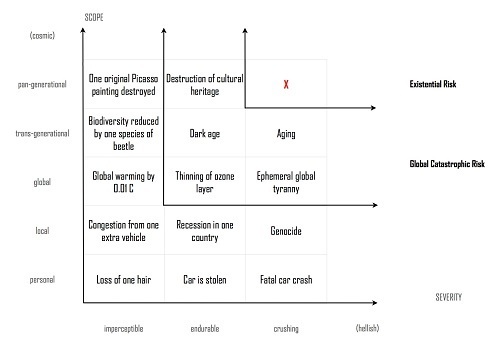
Xrisk has become a popular shorthand for this whole spectrum of risks. We can see signs of it emerging as a priority for various space-related efforts. One of the most popular images of Xrisk today is that of a sterilizing asteroid strike. And asteroids play a big role in some of the most visible efforts in space industry today, such as the ARKYD telescope or NASA’s asteroid initiative. Specialists sometimes see unpredicted cultural or technological Xrisks as even more urgent.
Starship Congress had its eye on some pretty long-term goals, and Earth provides our only space and time to work towards them. On that basis alone, the challenge of Xrisk must be answered.
But setting aside our own goals, what are the stakes? How many lives have there been, or could yet be if extinction is avoided? Nick Bostrom has run some interesting numbers.
“To calculate the loss associated with an existential catastrophe, we must consider how much value would come to exist in its absence. It turns out that the ultimate potential for Earth-originating intelligent life is literally astronomical.” [2]
How so? First we need a standard for measurement. Let’s start with the total number of humans ever to have lived on Earth. Wolfram Alpha lists the total world population as 107.6 billion people over time. The current global population is 7.13 billion. If we leave out the current population, we get 100 billion — About the number of neurons in a single human brain.
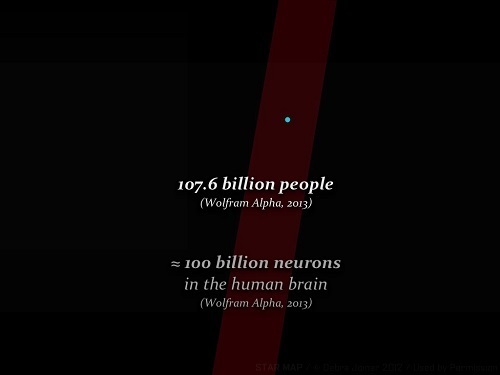
100 billion lives.
One Pale Blue Dot.
Here’s an excerpt of Carl Sagan’s thoughts on that famous image of Earth from afar:
Consider again that dot.
That’s here. That’s home. That’s us. On it everyone you love, everyone you know, everyone you ever heard of, every human being who ever was, lived out their lives. The aggregate of our joy and suffering, thousands of confident religions, ideologies, and economic doctrines, every hunter and forager, every hero and coward, every creator and destroyer of civilization, every king and peasant, every young couple in love, every mother and father, hopeful child, inventor and explorer, every teacher of morals, every corrupt politician, every “superstar,” every “supreme leader,” every saint and sinner in the history of our species lived there – on a mote of dust suspended in a sunbeam.
In … all this vastness … there is no hint that help will come from elsewhere to save us from ourselves. The Earth is the only world known, so far, to harbor life. There is nowhere else, at least in the near future, to which our species could migrate. Visit, yes. Settle, not yet. Like it or not, for the moment, the Earth is where we make our stand.
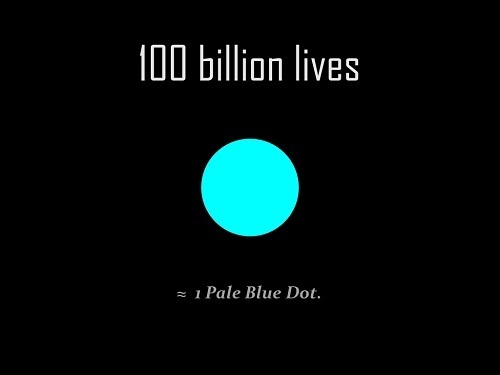
100 billion lives is our basic unit of measure.
Now; How much value would come to exist if our future potential is never cut short?
1016 — 10 million billion — is one estimate of the potential number of future lives on Earth alone, if only 1 billion lived on it sustainably for the 1 billion years it’s projected to remain habitable.
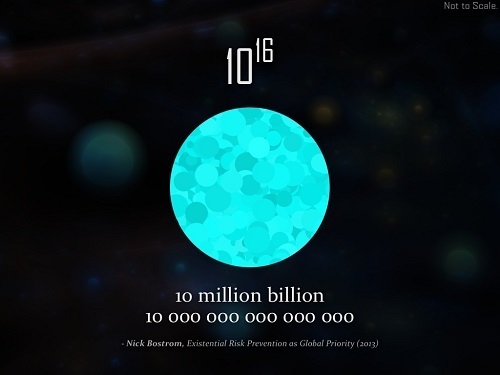
But if we consider the possibility of the spread of life beyond Earth, or synthetic minds and lives yet to come, Bostrom’s estimate [2] grows vast:
1052 potential lives to come. 100 million x 100 billion x 100 billion x 100 billion x 100 billion
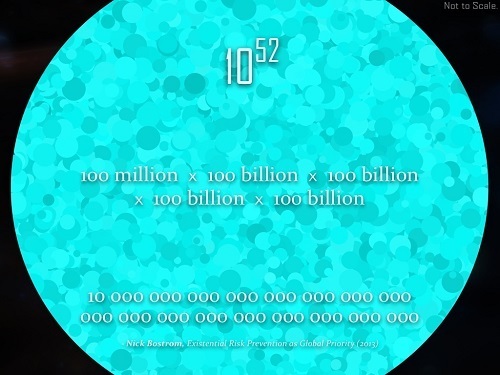
This means that reducing the chances of Xrisk by a mere 1 billionth of 1 billionth of 1 percent…
is worth 100 billion billion lives.
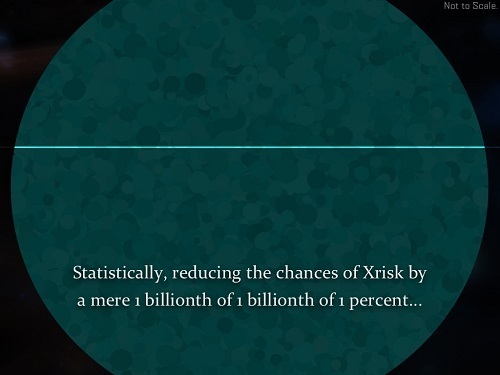

With just a slight shift in priorities, we can hugely boost the chances of life achieving its full future potential by working to enhance its prospects today.
Let’s look at Bostrom’s definition again: “An existential risk is one that threatens the premature extinction of Earth-originating intelligent life, or the permanent and drastic destruction of its potential for desirable future development.”
Notice that fragment – “… destruction of its potential for desirable future development.” Survival alone is not enough. In some cases, a surviving society may be brutalized, stagnant, or diminished irreparably, unable to aspire or to build itself anew. This brings us to two subtypes of Xrisk as crucial as extinction itself, and both fall into the realm of Global Catastrophic Risks.
Permanent Stagnation – Humanity survives but never reaches technological maturity or interstellar civilization.
Flawed Realization – Humanity reaches technological maturity but in a way that is irredeemably flawed.
Pop culture has a working knowledge of them both, in different terms. Nick and I joke that it’s a bit like: Zombies vs Vampires.
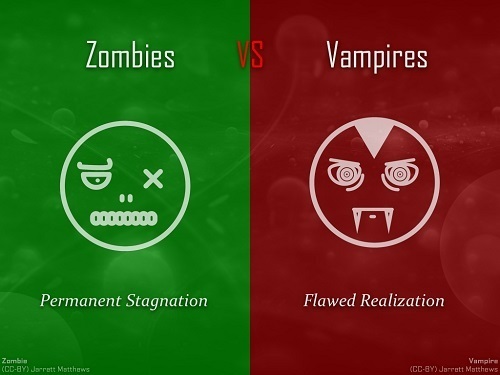
Permanent Stagnation and Flawed Realization. Losing our capability as a civilization, or enduring only in a deeply flawed form. These two risks fill our dystopian movies. But because popular culture understands them, we can learn valuable lessons about our messaging and priorities by understanding them too.
These two types of Xrisk cut to the heart of what it means to achieve our full potential. There is a vast opportunity between these risks, because of the many advances needed to achieve an interstellar future – and because of the benefits such advances could have for life on Earth — in areas such as habitat design, energy infrastructure, biotechnology, as well as advanced computing, networking, and archival.
If we work to prototype here and now, solving real-world problems along the way, all will benefit. If we make advances open and adaptable to humanity’s best minds, we will gain allies in our effort to uplift Earth and thrive beyond it. Perhaps advanced, resilient technologies could carry a seal standing for the dual design goals of uplifting life on Earth while advancing our reach towards the stars. Like LEED certification for an infinite future. What would such projects be like?
Last year, I proposed the Vessel project as a means to safeguard cultural potential on Earth and beyond. I’ll close with a brief update on this approach to advanced computing, compact habitat design, and long-term archival. With deep appreciation to Paul, I’ll continue in future guest entries by updating on the progress of the Vessel project, as I’ve continued to connect with interested specialists in several areas crucial to its implementation as a concrete strategy for Xrisk mitigation.

Image: Vessel Installation Symbol.
Vessel, as a design solution, begins with a simple premise: Capability lost before advanced goals are reached will be very difficult to recover, without a means of setting a baseline for civilization’s capabilities.
A Vessel is an installation, facility, or habitat that serves as a reservoir for Earth’s biological, scientific, and cultural record. Into a Vessel is poured what must be remembered for humanity’s potential to be maintained. On Earth or beyond, a Vessel habitat is designed to carry forth the sum of all we’ve been. In 2012, Vessel was pictured as the Lilypad seasteading habitat.

But different Vessels would have different designs based on their needs and settings. These traits remain key in each case:
At a Vessel’s core would lie biological archives, meant to preserve key traces of Earth’s biodiversity. Here the primary model is Gregory Benford’s groundbreaking 1992 Library of Life proposal. Benford details a program for freezing and preservation of endangered biomass for possible future recovery. [4]
Also crucial would be core archives for cultural and scientific knowledge, both physical and digital. I’m working with Icarus Interstellar to make sure the Vessel framework is compatible with Icarus projects. Several examples exist of information storage technologies engineered to endure the passage of time, such as the digital DNA encoding strategies of George Church’s team as well as Ewan Birney and Nick Goldman’s approach, the fused quartz technologies of Hitachi or Jingyu Zhang, and the Rosetta Disk project of the Long Now Foundation, which is the first deliverable for their Library of the Long Now. As yet I have not seen it proposed that such initiatives could or should be brought together in the service of a unified goal or project. Throughout 2014, I will be surveying these proposed strategies, as well as interviewing (when possible) their inventors and project leads on potential implementations.
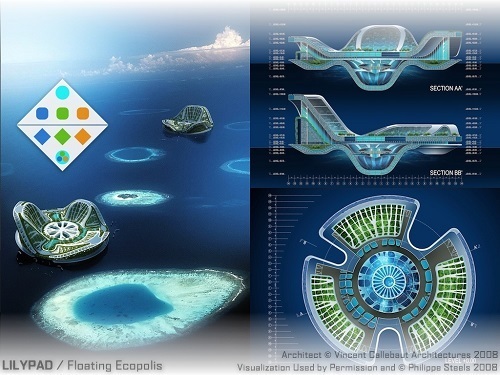
Surrounding these archives would be Research Labs, where specialists could collaborate on advanced technologies, seeking critical paths which avoid and mitigate Xrisk. Or, in a time of recovery, sealed labs could be the birthplace of new beginnings. Research Labs would open inwards to draw upon the Core Cache. Experts in their relevant fields could be both stewards and users of the core archives.
But in the near term, through an outer ring of Learning Labs, Vessel facilities could welcome the curious, and give visitors an inspiring glimpse at advanced studies. Immersive labs could be catalysts for change, helping people understand the arc of history in nature, culture and science, the common risks ahead, and the limitless possibilities if Earth achieves its full potential. This function, familiar in one form to any who have visited a nature & science museum and seen paleontologists at work, hints at a pathway towards actual present-day implementations of the Vessel project as popular, well-attended, comprehensive exhibitions for a public trying to make sense of the patterns of our present day.
Built around these three roles — of Learning, Research, and Archival — the Vessel framework is designed to adapt to any setting or situation. What all Vessels would have in common is a dedication to preserving cultural capability, and a layered, approachable presence adapted to its setting. Many should be built, using many approaches. Some could be public, while mission critical Vessels may be as remote as the Svalbard Seed Vault, or even secret.
Some may be massive as habitats, with others more like sculptures, compact and dense as a room. At the recent Starship Century conference in May, Freeman Dyson envisioned terrarium-like habitats which could seed the vast reaches of space with life. This egg-like approach is hugely inspiring to ponder from the perspective of the Vessel project. Whether urban or remote, extreme habitats or modules on a starship, Vessel is offered as a flexible framework for the long term survival of life’s capabilities.
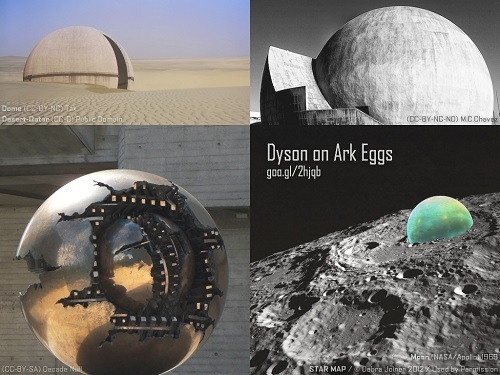
The Vessel project has several routes forwards. Plans for 2014 include the previously mentioned global survey of existing long-term archival projects, an open design document to help others adapt and evolve the Vessel framework (on which I am already working with a small team of interested artists and specialists), and a Kickstarter for a Vessel- related art project. And, at the invitation of Paul Gilster, we can add to these plans our regular updates on the Vessel project’s progress to the readers of Centauri Dreams. While I explore the nuts and bolts of Vessel’s critical path to an implementation, Nick will help deepen our grasp of the long term potential for a civilization that has chosen to mitigate Xrisk.
Right before Starship Congress, I began an Internship with the Long Now Foundation, working on a project called the Manual for Civilization (See here and here). As the first core collection for their planned Library of the Long Now, a 10,000 year archive, this work will overlap deeply with the Vessel project. So, my own timeline for Vessel is in flux. But if you’d like to collaborate, discuss ways of applying Xrisk mitigation to your own work, or want to help accelerate these efforts, please get in touch. You can register for updates on the Vessel project at vessel.cc.launchrock.com.
And, you can ask questions in the comments; both I and Nick will do our best to answer.
Our discussion of Xrisk continues tomorrow with Nick Nielsen.
——-
[1] 100 Year Starship. 2011. “The 100-Year Starship Study: Strategy Planning Workshop Synthesis & Discussions” (http://100yearstarshipstudy.com/100YS...). Accessed August 2012.
[2] Bostrom, N. “Existential Risk Reduction as Global Priority” (http://www.existential-risk.org/conce...). Accessed August 2013.
[3] Sagan, C. Pale Blue Dot: A Vision of the Human Future in Space (Random House, 1997).
[4] Benford, G. “Saving the library of life,” Proceedings of the National Academy of Sciences 89, 11098-11101 (1992).






August 28, 2013
Sun-Skimming Planets (and a Riff on Brown Dwarfs)
It’s time to catch up with recent exoplanet finds out of MIT as I start weaving in recent news with conference notes and ideas from other reading. Kepler 78b is much in the news because of its orbit, which takes it around its star in a breathtaking 8.5 hours, so that you can cram almost three Kepler 78b years into a single Earth day. That means, of course, that this is a planet that all but skims its star, with an orbital radius about three times the radius of the star. In Solar System terms, we’re talking about a world forty times closer to its star than Mercury is to the Sun.
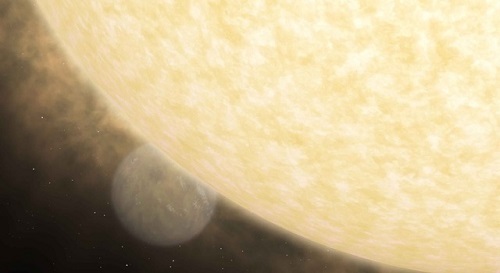
Image: A scorched Kepler 78b may have yet more to tell us, as the article below explains. Credit: NASA/JPL-Caltech.
With temperatures somewhere between 2300 K and 3100 K on the bright side (and I would assume this is a tidally locked world), we would be looking at a veritable ocean of lava on the surface. This MIT news release points out that because the researchers were able to detect the light emitted from the planet, we should be able to parse out further information about the composition of that surface and its reflective properties. From the paper on this work:
The robust detections of the occultations of the planet by the star, and of the time-variable illuminated fraction of the planet as it orbits around the star, make the system important for future observational and theoretical work. Observations with finer time sampling could better pin down the transit parameters. This in turn would clarify the equilibrium temperature of the planet’s dayside… It is unclear at this point if the occultations would be large enough in any band to be detected with any telescope besides Kepler, but the prospect of studying the surface or atmosphere of an Earth-sized exoplanet may be attractive enough to justify a large investment of telescope time.
Kepler 78b orbits a late G-class star and has, according to the paper, the shortest orbital period among all planets yet found transiting a main sequence star. The researchers, led by Roberto Sanchis-Ojeda (M.I.T. Kavli Institute for Astrophysics and Space Research) note that the rarity of giant planets in orbits this tight may be the result of smaller rocky worlds being less vulnerable to tidally-induced decay of their orbits. Among the other Kepler Objects of Interest (KOI) are 17 exoplanet candidates with orbital periods of less than 16 hours and inferred planetary sizes smaller than that of Neptune.
All this intrigues me especially because of my interest in brown dwarfs, dim and cool enough that a planet needing warmth for habitability would have to orbit exceedingly close to the object. Then we come to work on KOI 1843.03, a still unconfirmed candidate whose transit period is a mere 4.5 hours. The MIT team involved with this one, led by Saul Rappaport, finds that for a planet to orbit its star this closely, it must be extremely dense to prevent tidal forces from disrupting it.
The paper on this candidate argues that while planets with masses from 0.1 to 8 Earth masses can exist with orbital periods as low as 3.5 hours, they must be composed largely of iron with silicate mantles. “A number of planets with very short orbital periods are starting to be found,” the paper adds, “and a continuing search for them is likely to prove fruitful.” And later:
We find it interesting that constraints on the composition of close-in terrestrial planets can be obtained from such elementary considerations. There remain, of course, profound questions about why planets actually exist in such close-in orbits, which we will leave for another day.
The Rappaport work is interesting because of its methodology. The Roche limit is the distance from the star where its tidal forces would disrupt the planet and cause it to disintegrate. Even a small planet has to orbit outside that limit. Rappaport’s team argues that these ultra-short period candidates can be studied by using the Roche calculations to set limits on the planet’s mean density. If the planet’s radius can be measured by studying its transits (this contrasts transit depth with measured stellar radius) then the composition of the planet can be inferred.
Musing on Close Planets and Brown Dwarfs
Neither Kepler 78b (a G-class primary) nor KOI 1843.03 orbits a star anywhere as faint as a brown dwarf, but let’s extend our speculations to these dim objects. Nature seems to be telling us to expect planets just about everywhere we look. It will be fascinating to learn whether or not brown dwarfs can sustain planets pushing up against the Roche limit and thus remaining warm enough to sustain some kind of life. Gregory Benford’s story “The Man Who Sold the Stars” explores at its conclusion what a planet orbiting a dim Y-class brown dwarf might look like. Imagine, then, being on the surface of a planet circling the brown dwarf called Redstar:
Even though their helmets amped the visible spectrum, the effect was eerie. Stars shone in pale gray here against the inky black. The huge hull of Redstar hung as a burgundy disk cut off by the sea. Here and there across the long panorama of perpetual twilight, slanting rays of a deep Indian red showed floating plants, lapping on the waves in a somber sprawl. Everything glowed with infernal incandescence…. Down from the desolate slope to his left came an echoing cry, long and slow. In the thick air a thing like a huge orange gossamer butterfly fluttered on a thin wind. It swooped across a sky peppered with amber clouds and vanished with deliberate, long flaps of its enormous wings, vanishing behind a low eroded hill.

Image: Can a brown dwarf produce planets close enough to the object to be habitable? Credit: NASA, ESA, and JPL-Caltech.
A place like this is worth looking for, which is why brown dwarfs have such a large place in my imagination. Whether or not a Y-class dwarf could produce planets in such a configuration is something that only future observation will tell us. We are, though, beginning to learn the tricks of observing planets moving incredibly close to their parent star.
The paper on Kepler 78b is Sanchis-Ojeda et al., “Transits and Occultations of an Earth-Sized Planet in an 8.5 hr Orbit,” Astrophysical Journal Vol. 774, No. 1, p. 54 (abstract). The paper on KOI 1843.03 is Rappaport et al., “The Roche limit for close-orbiting planets: Minimum density, composition constraints, and application to the 4.2-hour planet KOI 1843.03,” Astrophysical Journal Vol. 773, No. 1, L15 (abstract). Greg Benford’s story is available in the Starship Century anthology.






Sun-Skimming Stars (and a Riff on Brown Dwarfs)
It’s time to catch up with recent exoplanet finds out of MIT as I start weaving in recent news with conference notes and ideas from other reading. Kepler 78b is much in the news because of its orbit, which takes it around its star in a breathtaking 8.5 hours, so that you can cram almost three Kepler 78b years into a single Earth day. That means, of course, that this is a planet that all but skims its star, with an orbital radius about three times the radius of the star. In Solar System terms, we’re talking about a world forty times closer to its star than Mercury is to the Sun.

Image: A scorched Kepler 78b may have yet more to tell us, as the article below explains. Credit: NASA/JPL-Caltech.
With temperatures somewhere between 2300 K and 3100 K on the bright side (and I would assume this is a tidally locked world), we would be looking at a veritable ocean of lava on the surface. This MIT news release points out that because the researchers were able to detect the light emitted from the planet, we should be able to parse out further information about the composition of that surface and its reflective properties. From the paper on this work:
The robust detections of the occultations of the planet by the star, and of the time-variable illuminated fraction of the planet as it orbits around the star, make the system important for future observational and theoretical work. Observations with finer time sampling could better pin down the transit parameters. This in turn would clarify the equilibrium temperature of the planet’s dayside… It is unclear at this point if the occultations would be large enough in any band to be detected with any telescope besides Kepler, but the prospect of studying the surface or atmosphere of an Earth-sized exoplanet may be attractive enough to justify a large investment of telescope time.
Kepler 78b orbits a late G-class star and has, according to the paper, the shortest orbital period among all planets yet found transiting a main sequence star. The researchers, led by Roberto Sanchis-Ojeda (M.I.T. Kavli Institute for Astrophysics and Space Research) note that the rarity of giant planets in orbits this tight may be the result of smaller rocky worlds being less vulnerable to tidally-induced decay of their orbits. Among the other Kepler Objects of Interest (KOI) are 17 exoplanet candidates with orbital periods of less than 16 hours and inferred planetary sizes smaller than that of Neptune.
All this intrigues me especially because of my interest in brown dwarfs, dim and cool enough that a planet needing warmth for habitability would have to orbit exceedingly close to the object. Then we come to work on KOI 1843.03, a still unconfirmed candidate whose transit period is a mere 4.5 hours. The MIT team involved with this one, led by Saul Rappaport, finds that for a planet to orbit its star this closely, it must be extremely dense to prevent tidal forces from disrupting it.
The paper on this candidate argues that while planets with masses from 0.1 to 8 Earth masses can exist with orbital periods as low as 3.5 hours, they must be composed largely of iron with silicate mantles. “A number of planets with very short orbital periods are starting to be found,” the paper adds, “and a continuing search for them is likely to prove fruitful.” And later:
We find it interesting that constraints on the composition of close-in terrestrial planets can be obtained from such elementary considerations. There remain, of course, profound questions about why planets actually exist in such close-in orbits, which we will leave for another day.
The Rappaport work is interesting because of its methodology. The Roche limit is the distance from the star where its tidal forces would disrupt the planet and cause it to disintegrate. Even a small planet has to orbit outside that limit. Rappaport’s team argues that these ultra-short period candidates can be studied by using the Roche calculations to set limits on the planet’s mean density. If the planet’s radius can be measured by studying its transits (this contrasts transit depth with measured stellar radius) then the composition of the planet can be inferred.
Musing on Close Planets and Brown Dwarfs
Neither Kepler 78b (a G-class primary) nor KOI 1843.03 orbits a star anywhere as faint as a brown dwarf, but let’s extend our speculations to these dim objects. Nature seems to be telling us to expect planets just about everywhere we look. It will be fascinating to learn whether or not brown dwarfs can sustain planets pushing up against the Roche limit and thus remaining warm enough to sustain some kind of life. Gregory Benford’s story “The Man Who Sold the Stars” explores at its conclusion what a planet orbiting a dim Y-class brown dwarf might look like. Imagine, then, being on the surface of a planet circling the brown dwarf called Redstar:
Even though their helmets amped the visible spectrum, the effect was eerie. Stars shone in pale gray here against the inky black. The huge hull of Redstar hung as a burgundy disk cut off by the sea. Here and there across the long panorama of perpetual twilight, slanting rays of a deep Indian red showed floating plants, lapping on the waves in a somber sprawl. Everything glowed with infernal incandescence…. Down from the desolate slope to his left came an echoing cry, long and slow. In the thick air a thing like a huge orange gossamer butterfly fluttered on a thin wind. It swooped across a sky peppered with amber clouds and vanished with deliberate, long flaps of its enormous wings, vanishing behind a low eroded hill.

Image: Can a brown dwarf produce planets close enough to the object to be habitable? Credit: NASA, ESA, and JPL-Caltech.
A place like this is worth looking for, which is why brown dwarfs have such a large place in my imagination. Whether or not a Y-class dwarf could produce planets in such a configuration is something that only future observation will tell us. We are, though, beginning to learn the tricks of observing planets moving incredibly close to their parent star.
The paper on Kepler 78b is Sanchis-Ojeda et al., “Transits and Occultations of an Earth-Sized Planet in an 8.5 hr Orbit,” Astrophysical Journal Vol. 774, No. 1, p. 54 (abstract). The paper on KOI 1843.03 is Rappaport et al., “The Roche limit for close-orbiting planets: Minimum density, composition constraints, and application to the 4.2-hour planet KOI 1843.03,” Astrophysical Journal Vol. 773, No. 1, L15 (abstract). Greg Benford’s story is available in the Starship Century anthology.






August 27, 2013
Neil Armstrong: One Small Friendship Remembered
Neil McAleer is probably best known in these pages for his fine biography Visionary: The Odyssey of Arthur C. Clarke (Clarke Project, 2012), but this is just one of his titles. In fact, his book The Omni Space Almanac won the 1988 Robert S. Ball Award from the Aviation and Space Writers Association, and his work has appeared in magazines from Discover to the Smithsonian’s Air & Space and in many newspapers. A recent note from Neil reminded me that August 25th marked one year since the death of Neil Armstrong. This reminiscence of the astronaut brings Armstrong wonderfully to mind and gives us a bit more of Clarke, leaving me to wonder only how time has gone by so quickly in the days since the death of both men. McAleer’s article also gives me a chance to pause in Starship Congress coverage as I begin to collect papers from many of the presenters, the first of which we’ll be looking at a bit later this week.
by Neil McAleer
From the great deep to the great deep he goes.
— Alfred Lord Tennyson
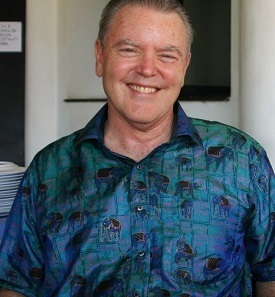
The first letter I ever received from Neil A. Armstrong was dated May 21, 1987. Earlier that month, I had sent his office a copy of my recently published The OMNI Space Almanac with the hope he would agree to read and verify its text covering the final descent and landing on the moon of the Apollo 11 mission.
I had no clue if he would respond to my request or not, but it was worth a try. When I saw Lebanon, Ohio, on his return address a few weeks later, I was thrilled to have his reply — whatever it said. He thanked me for the book and wrote:
“I have been overwhelmed with business obligations this past several months, and have not yet had the chance to read it carefully.
“I will give my comments when the pressure subsides.”
Of course, I was all but certain that his pressure would never subside, but I was very grateful for his words.
That letter was my bonding with Armstrong for life, and it began a small friendship that lasted over 21 years and was sustained through occasional letters, emails, and phone conversations, several of which were interviews for my various works in progress.
Five months after receiving that special letter, in October 1987, I published a piece in Space World, “The Space Age Turns 30,” for which I interviewed 26 astronauts, science fiction and science writers, and various other space experts, asking them where they were when Sputnik 1 was launched — the event that would forever mark the beginning of planet Earth’s space age. Among the astronauts I interviewed for this piece were all three Apollo 11 crew members: Neil Armstrong, Buzz Aldrin, and Michael Collins.
Here is the published text that was distilled from the Armstrong interview that took place in the summer months of 1987.
“You know, going back 25 years or more and trying to remember something accurately is dangerous. I think many people remember what they remember rather than what happened.
“My recollection is that I was at the Society of Experimental Test Pilots symposium at Los Angeles at the time. The SETP symposium is always in the fall, about the time of the World Series. And I believe that to be true because I remember that it caused the Society some consternation at its inability to get press coverage, when every journalist was concentrating on Sputnik.
“I was flying various projects at Edwards Air Force Base at the time, including the X-15. [Its first flight took place post-Sputnik, in June 1959.] Those of us at Edwards High Speed Flight Station were working on projects we thought might lead eventually to spaceflight, so I’m certain that Sputnik was of extreme interest and concern to all of us in that business. What it came down to was: The Russians had one and we didn’t. We got one and then went on to the Moon.”
Those last two short sentences let us into the mind and heart Armstrong — the core of the man — as few short phrases can: Cut to the essence; cut to the action; take over the manual controls to land successfully on the moon! It demonstrates the truth of the succinct phrase describing him in his high school yearbook: “He thinks, he acts,’tis done.”

Image: Neil Armstrong as I (PG) like to remember him, a laser-focused professional at the top of his game.
Neil and I had two more informal project interviews, with follow-up correspondence, for works in process. One interview took place on March 16, 1989, which was part of my research for my first Arthur C. Clarke biography, originally published in 1992. The second focused on Neil Armstrong himself, a 1994 piece in the Baltimore Sun (“Neil Armstrong, Reluctant Hero”) that celebrated the 25th anniversary of the Apollo 11 landing, and the exemplary character of its commander, Neil A. Armstrong.
This piece was primarily my research, but I sent a draft to Neil and followed up with a phone call. My intent here was to make sure there were no egregious or even minor errors, which I knew he would tell me about if they appeared. Armstrong’s reach for excellence was ever-present.
My memory tells me that the last phone conversation/interview we had was for this Baltimore Sun piece in the spring of 1994, but there were a few email exchanges during the rest of the 1990s and into the first decade of the 21st century.
I was completely unaware of the last letter from Neil Armstrong that I played a part in. It wasn’t until I visited Arthur Clarke at his home in Colombo Sri Lanka, for the first time in April-May 2004 that I learned about it and read the original there.
Before my trip I wrote Neil to tell him I was making the long voyage over. It would be the first and last time I saw Arthur Clarke in his native habitat, where he chose to live in the 1950s. I was seeking a few special “gifts” to bring Arthur. Neil had said this about Clarke in a speech at the National Press Club in February of 2000:
“For three decades I have enjoyed the work and friendship of Arthur Clarke, a prolific science and science fiction writer, who back in 1945 first suggested the possibility of the communications satellite. In addition to writing some wonderful books, he has also proposed a few memorable laws. Clarke’s third law seems particularly apt today: Any sufficiently developed technology is indistinguishable from magic. Truly, it has been a magical century.”
My letter to Neil, dated April 10, 2004, read in part: “I’m taking a brand spanking ‘new’ copy of ‘The Engineered Century’ piece from The Bridge* in Spring 2000 to Sri Lanka with me to give to Arthur as a gift… Would it be possible for you to sign and date a copy to him on the first page of your piece?” (This was after Neil Armstrong had put a moratorium on requests for his signatures. “Unless I sign the wet concrete of a building cornerstone, and it can’t be carried away,” he told me once.)
* A quarterly magazine, issued by the National Academy of Engineers. This article was an edited version of a speech Armstrong delivered at the National Press Club, 22 February 2000.
Neil’s answer came back the next day: “I will be happy to help out as you have suggested. I will mail the book directly to Arthur to save you the trouble of carting it to Sri Lanka.”
After arriving at Clarke’s home and office in Colombo in late April, I asked Arthur if a package had arrived from Neil Armstrong. “Yes,” he said. “The inscribed Bridge and a letter.”
The letter was a complete surprise to me—and much more significant than an accompanying note.
It was the best letter written by Neil Armstrong that I had ever seen because it was a personal one to Clarke, who at 87 years was having multiple medical issues, including memory loss. And Armstrong’s humor and personality came through clearly in his words.
So two gifts had been sent to Arthur by Neil Armstrong: the inscribed magazine that was a cooperative initiative between the two of us; and his wonderful letter to Arthur—now in the Clarke archives. A photograph of that letter is below.

And here is Neil’s article with inscription to Clarke:
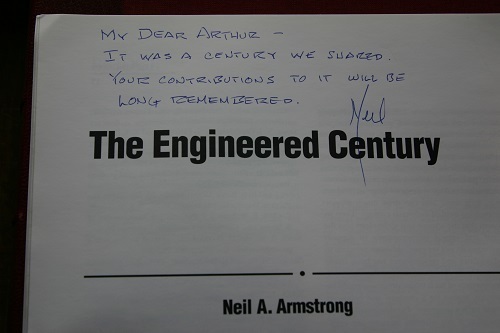
There was a brief email exchange between us in mid-October 2005. I happened to see an obituary in the New York Times of a fellow test pilot that he may have missed, so I forwarded it on. I first sent this with a brief personal note attached to his office via the NY Times email forward, but apparently it never arrived. So I sent it again, “in a more straightforward manner,” and he replied a few days later:
“Thank you for the obit on George Watkins. Although I get the Times, I did not see the article. I didn’t know George well, but he came to Edwards on a number of occasions when I was working there.”
The fact that he replied at all to such an off-the-cuff brief forward was indicative of Neil’s warmth and generosity. But I was especially happy about the consistent use of abbreviated greetings and signature closings that framed this round of emails: I had headed mine: Neil A. from Neil M., and he replied with: Neil M. from Neil A. He accepted the usage. And he kept his message short: “‘Tis done.”
Our last emails were sent during 2008, the year that Arthur C. Clarke died at the age of 90 (March 19). Several months later, not long after Neil celebrated his 78th birthday on August 5, I brought him up to date and sent him a link to the last professional photographs of Clarke taken shortly before he died. That was our final communication—some 21 years after I received Neil’s first letter.
I never met Neil Armstrong face to face, but I knew him through his own words and voice, and our small friendship was life-changing for me. In the 1980s, our occasional interactions renewed and invigorated my natural propensity for optimism that had slowly gone into hibernation during my forties.
I’ve always thought of Neil when looking at the moon—ever since he and Buzz and Mike flew there and back, not quite a half century ago. Like countless admirers around the planet, I too grieved last August, reluctant to give up the hope that he had many more good years left. I genuinely thought Neil would be with us for the 50th Anniversary of Apollo 11 in 2019—and I take great comfort in the fact that his life story and giant spirit will always be with us.






August 26, 2013
Interstellar Studies in Context
With the beginning of a new week it’s time to ponder how best to move forward with coverage not only of the recent Starship Congress in Dallas, but the upcoming 100 Year Starship Symposium in Houston. For that matter, I still have material from the Starship Century event in San Diego, a gathering I was unable to attend but which continues to be available online. The Starship Congress videos are also up for those who missed Dallas, and I’m going to assume the Houston conclave will likewise be recorded. Watching online can’t match the interaction and conversation of being there, but getting to hear the presentations is a major plus.
What I’ll be doing as Houston approaches is continuing to reflect on the conferences I’ve attended so far this year while also trying to keep up with ongoing news. In the days since Dallas I have continued to speak with a number of presenters who will be joining us, as Charles Quarra did on Friday, with reports on their own work. Several have also agreed to drop in as regular columnists, so we’ll be tracking ongoing progress in a number of interesting areas as reported by people directly involved. I’m seeing the level of engagement between researchers and the public growing, a fact that speaks well for using the Internet to move the ball forward.
Interstellar Flight Before DARPA 2011
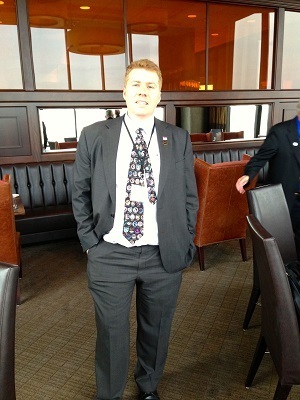
Kelvin Long is head of the Institute for Interstellar Studies and one of the founders of Project Icarus, the attempt to redesign the Project Daedalus fusion starship of the 1970s. As befits the latter, he is also editor of the Journal of the British Interplanetary Society, whose role in interstellar studies has always been immense. It was Geoffrey Landis who told me many years back that JBIS (‘J-biz,’ as it is affectionately known) had been the home of advanced concept thinking for decades, and as a BIS member myself, I can tell you that seeing that familiar cover appear in my mailbox renews my energy levels for tackling these issues.
Project Daedalus, of course, was designed largely in London’s pubs, particularly the Mason’s Arms, while Project Icarus takes a different tack, the effort being distributed over the Internet in addition to gatherings at conferences (and yes, the occasional pub still crops up). When Long spoke to Starship Congress, he offered up a history of the field as it grew from the Renaissance musings of Leonardo da Vinci all the way through the first astronauts on the Moon and into the present day. It was a useful session (and I thank Kelvin for the kind words about Centauri Dreams) because it helped to frame where we are today in relation to the DARPA grant of 2011 that drew so much press attention.
The DARPA grant of $500,000 resulted in the 100 Year Starship organization that is putting on the upcoming Houston conference, and in many ways awakened public interest in the idea that a trip to the stars was feasible. Popular science fiction on television and in the movies has for the most part made star travel out to be a simple matter, and it’s my guess that the average home viewer looks at the Enterprise flitting about the galaxy and regards the idea of star travel as something akin to fantasy. Thus to have newspapers and other venues begin to report in on serious work that researchers were performing came as a bit of a surprise to many.
Who knew that so much was going on, even if most of it was not being funded by government agencies? Kelvin and I have had this discussion before, and I’m always glad that he hearkens back to Les Shepherd, the British nuclear physicist who played such a large role not only in the British Interplanetary Society but in organizations like the International Astronautical Federation, which he served twice as president. Also a founder of the International Academy of Astronautics, Shepherd wrote a key paper in 1952 called “Interstellar Flight,” another JBIS contribution that moved the field forward by looking critically at how to move a starship.
Here I think of Giovanni Vulpetti’s words about Shepherd, which he kindly supplied for my obituary of the man that ran early last year:
Dr. Shepherd realized that the matter-antimatter annihilation might have the capability to give a spaceship a high enough speed to reach nearby stars. In other words, the concept of interstellar flight (by/for human beings) may go out from pure fantasy and (slowly) come into Science, simply because the Laws of Physics would, in principle, allow it! This fundamental concept of Astronautics was accepted by investigators in the subsequent three decades, and extended/generalized just before the end of the 2nd millennium.
Long’s talk went through Shepherd’s work and touched on many of the figures that have helped the field grow. On the first night of Starship Congress, Heath Rezabek gathered a number of those who had submitted proposals to DARPA for the 2011 grant, including Joe Ritter’s Starship Alliance and the Tau Zero Foundation. I was asked to supply some closing remarks to that event and gave the audience my view that the DARPA grant had put the earlier interstellar work into context and raised its visibility, firming up the idea that journeys to the stars moved beyond fantasy into the realm of extraordinarily difficult but not impossible mission challenges.
Like Long, I went through many of the names of the great players. After Shepherd, Eugen Sänger came to mind with his work on a so-called ‘photon drive’ in the 1950s. The great Robert Forward more than anyone worked out the physics of antimatter and sail possibilities and studied how powerful laser or microwave beams could drive a starship. George Marx wrote a seminal paper on beamed propulsion, while Clifford Singer studied particle beams to drive the craft. Gregory Matloff and Eugene Mallove examined worldships and sails (Matloff, of course, is still active), while the aforementioned work on Project Daedalus gave us the first true starship design.
The background is indeed rich, and bear in mind that many of these researchers were doing this work in their spare time while holding down demanding positions at labs or universities. The interstellar effort has been driven largely by will and determination. Alan Bond and Anthony Martin of Daedalus fame conceived new ideas for worldships, while in Italy the physicists Giovanni Vulpetti, Claudio Maccone and engineer Giancarlo Genta ignited an Italian solar sail effort that defined the issues and developed mission concepts that are still under investigation. One of these, Maccone’s FOCAL, is an ambitious mission to the Sun’s gravitational focus.
I won’t spend the entire post dwelling on the past, but it’s worth remembering that when Robert Forward was nearing the end of his life, he declared Geoffrey Landis (NASA GRC) to be his successor, and Landis indeed worked through many of the problems in sail materials that so interested Forward. The DARPA grant didn’t happen until 2011, but in the mid-90s we had the Vision-21 conference at NASA Glenn (then Lewis Research Center) followed by the creation of the Breakthrough Propulsion Physics project under Marc Millis. Ed Belbruno ran a conference called Robotic Interstellar Flight: Are We Ready in New York in 1994, this one sponsored by The Planetary Society and with involvement from NASA and JPL. The point is that tough-minded researchers have been tackling these issues since long before the public began to notice. We can hope the new interest will be quickened by future events, the most likely driver being the discovery of a truly Earth-like world around a star close enough for detailed study.
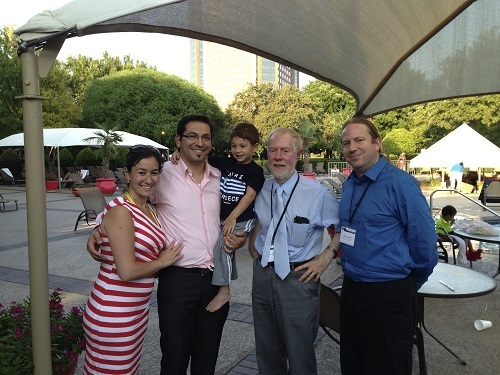
Image: Icarus Interstellar’s Andreas Tziolas, along with wife Zoi Maroudas-Tziolas, son Constantine, myself and, to my left, my son Miles.
Awakening the Mythos
Meanwhile, we continue with the interstellar effort while acknowledging that this is a multi-generational quest. The critical scientific and engineering studies are increasingly engaging the strands of science fiction and the popular media as the effort continues. We are discovering interest from sociologists, psychologists, historians, biologists, making the case that this is not a project that can remain purely a matter of physics and engineering. To engage the public we need the humanists as well, for we must ignite the vision in our culture, communicating sound reasons for deep space.
I sometimes turn to the Greek word mythos in describing what is happening. It’s the origin of the word myth, of course, and it has a range of meanings from ‘word’ through ‘fiction.’ The Greeks used ‘logos’ to mean ‘word’ as well, but logos was the word that can be argued and demonstrated, whereas mythos aimed at something ineffable, beyond argument, something that could provide guidance for the critical aspects of our lives. Mythos is all about how we face death, how we confront falsehood, how and where we find the meaning that keeps us going. Tennyson has Ulysses, that great figure of Homeric myth, speak for all those who go journeying:
“…my purpose holds
To sail beyond the sunset, and the baths
Of all the western stars, until I die.”
Whether consciously or not, we find in myths the inspiration we need to continue traveling. We tap mythos to get things done. In confronting the challenge of interstellar flight, we are re-learning what as a culture we knew in the days of ancient Athens and the earliest Chinese dynasties, that our works must not just reflect but surpass us. Because they are multi-generational, we must hand them along to our children so that they can build upon them to discover their meaning. Yes, we are dealing with the greatest problems of physics and engineering we have ever faced. But we know in our bones that to be successful, an interstellar effort must supercede all of this.
The problem of the starship, then, is problem of science but it is also a problem of philosophy as we choose how to live. The problem of the starship is a problem of engineering but it is also a problem of poetry, as we draw upon sources of inspiration to motivate our species. The starship mythos happens in that place where dreams confront reality and both grow and change from the experience. In leaving Earth we reinvigorate a mythos that may one day take us into the galaxy.






August 23, 2013
A Light Bridge to Nearby Stars
by Charles Quarra
Charles Quarra tells me that like many kids who grow up dreaming about the stars, he realized early on that a career in physics would make sense. A book-filled childhood helped fix this focus, especially Carl Sagan’s The Cosmic Connection and Peter Nicholls’ The Science in Science Fiction. Charles went on to get a Physics B.Sc degree from Universidad Simón Bolivar in Caracas in 2006, but adds “pursuing it as a career turned out to be less satisfying as time went on. I’ve also been programming most of my life, so a transition to a software development career felt almost too natural for me, which I’ve been doing since moving to Panamá in early 2008.” His interest in space propulsion and exploration, though, remains strong, as evidenced by the paper he presented at Starship Congress in Dallas, which looks at building a chain of stable equidistant laser relays to provide beamed power for interstellar spacecraft. In the post below, Charles summarizes what he has in mind.
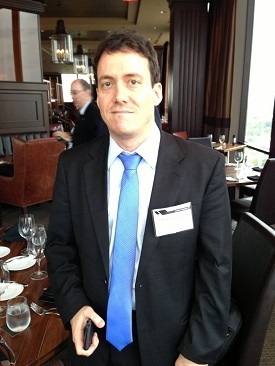
For decades since the beginning of the space age, mankind’s technological capabilities have grown exponentially in almost all but a few fronts of knowledge. One of the areas where evolution has been particularly frustrating is the result of the abysmal separation between our increasing capability to observe and find new potential places to visit, while our collective will to explore deeper and longer has stayed almost the same, if not languished at times. We seem to be the kids in front of the candy store of the universe, condemned to remain there for what seems like an eternity, while the object of our curiosity stays perpetually out of reach.
The ‘starway’ concept I present here is a natural evolution of the work of both Robert Forward and Geoffrey Landis in extending the reach of beamed power into deep interstellar space, by taming the beam divergence that is ever present in all laser wavefronts. Beamed power gives us the possibility of leaving the source of energy at home, avoiding the exponential blowout of energy requirements imposed by the Tsiolkovsky rocket equation. But beamed propulsion is far from devoid of issues: The pointing accuracy, the huge laser sources and sails tens or hundreds of kilometers wide demand engineering capabilities that are still far from our current horizon.
Handing Off Power to Starships
Conceptually, the starway tries to push the idea of multiple lenses for beam refocusing, analyzed by Landis in the 1990s, in the direction of making them reusable: Can we take a string of lenses, deploy them between two stars and keep them operational for long periods?
If so, the potential gains would be enormous: One of the problems that makes interstellar flight so hard is not only the extraordinary distances but also the almost entire absence of useful power required for propulsion. So a string of stabilized lenses in deep space would be able to deliver the required high energy density.
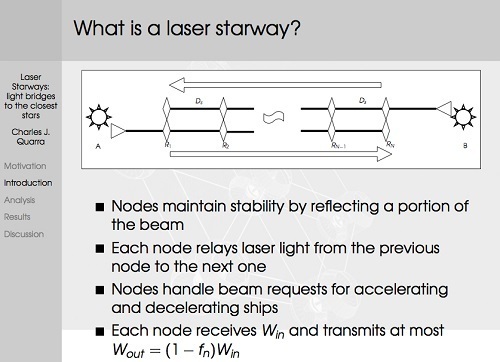
The conceptual step of stabilizing the lenses involves upgrading the elements to more than simple optical elements. We need slightly more complex relay devices capable of tasks that go beyond the simple optical refocusing of the beam: Reflection, beam splitting, heat rejection and telemetric coordination, to name a few other engineering requirements that the optical relays need to be able to do (sometimes simultaneously) in order to guarantee the continuity of power delivery along the structure, and toward nearby sails in transit. As it turns out, the principal parameter that determines the available power for sail propulsion on the light bridge structure is the optical efficiency of the relays: As the optical efficiency of the relays stays below the critical value (which for a starway made of thousands of nodes will imply losses per node around 100 ppm) the efficiency of the laser thrust utilization grows rapidly.
In order for sails to be able to take full advantage of the available power for maintaining constant acceleration without affecting their thermal envelopes significantly, material developments are needed: To handle the Doppler shifting of the beam relative to the sail rest frame, the sails either need to have reflectances with broad spectral peaks or they need to be made of tunable dielectric films that can electrically shift the peak. Dynamically adjusting the wavelength of the laser instead would not necessarily be a good strategy, since that would only translate the spectral efficiency problem from the sails to the optical relays, where efficiency is even more paramount in order to stabilize the starway.
Construction and Rationale
But does it make sense to deploy such structure? One of the vexing aspects in the starway architecture is the substantial requirement of deploying a laser system and solar collector array at the destination system. At first, the proposition seems ridiculous: If the capability is available to do it, why bother sending such substantial cargo instead of your actual intended payload?
The question can be answered only by specifying what we expect from interstellar flight. Do we want one-off missions, demanding huge investments with limited overlap and resource sharing? Or do we want to build a long-term infrastructure that, once deployed, consistently reduces the complexity and cost of subsequent interstellar flights? Interestingly, this is not the first time we had to deal with this same exact dilemma: Roman engineers perfected the technology to build large bridges over rivers that divided Roman territories and provinces. This technology was key to keeping the Roman Empire connected across most of Europe for several hundred years. Building bridges was undoubtedly a daunting task relatively compared to the effort required to cross the river in floating boats, but once they were deployed, the long-term benefits in reduced travel time and risk vastly exceeded any potential building costs.
Radial velocities will mean that certain stars are better suited for a starway than others. For instance, Gliese 581, at 20 light years, moves at a relatively slight pace of 10 kilometers per second. If we had 20,000 nodes (each at a 70 AU separation), we would have to add a new optical node in the starway every 30 years or so. For the same reason, Barnard’s Star (which is much closer, but has a velocity a lot higher than galactic escape velocity) would not be a good candidate for a starway, demanding several new nodes a year being pushed into the line.
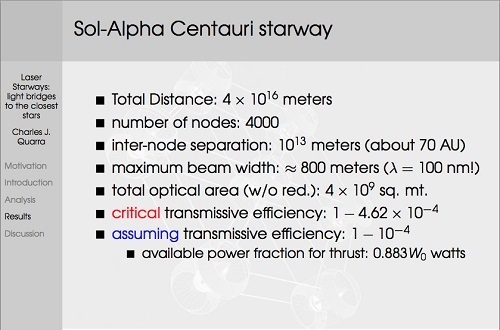
As promising as the concept sounds, there are a number of issues that need to be solved before we can start building them. First, we need to figure out exactly what it would take to deploy such a structure. A starting point for deployment analysis is the multiple-lensed beamed sail mission proposed by Geoffrey Landis, and the fact that this analysis exists goes a long way to proving that deployment is far from being impossible. Depending on the masses of the hundreds or thousands of relays, deployment might take somewhere between several decades to a few hundred years. But the grunt work of relay design is still ahead, and graphene has an enormous potential for reducing the relay mass, at least for the thermal management sections.
An Interstellar Communications Network
But assuming these technical problems can be addressed, an advanced civilization could spread by deploying starways between neighbouring stars. A interstellar network of this kind would not only enable interstellar transport, but would also make high-bandwidth communications much more feasible. Might such a communications network be detectable?
On the problem of SETI by detecting the signature of remote starways in our galactic backyard, I’ve been fortunate enough to have had interesting exchanges with Adam Crowl, an interstellar expert who requires no further introduction to the Centauri Dreams readership, on the possibilities of detecting starways from remote distances. Unfortunately, typical relay nodes are expected to be far too small (a few kilometers at most, if relying on lasers on optically visible wavelengths) to be detected with our current observational resolution. Starways connected to our solar system would require a array laser and probably some extensive solar energy capturing infrastructure that we should probably have already detected if it was present at all.
But beyond a starway’s transportation capabilities, the architecture can easily be extended to relay information in bi-directional interstellar channels. This could provide a partial but nonetheless interesting explanation why purposeful ETI interstellar communications in radio bands seem to be largely absent: Communications are being exchanged by the equivalent of private end-to-end starway networks, largely out of the prying eyes of naive observers like us
Interestingly, the refocusing element design of a starway will profit from certain key developments in adaptive optics and optical mirror mass reduction that are highly sought by the astronomical community. In this regard, the unscheduled talk of Joseph Ritter from the University of Hawaii at Maui at Starship Congress was particularly enlightening, showing interesting possibilities for extending optical resolutions from the ground to the nano-radian range. Quoting my friend Miles Gilster, wouldn’t it be extraordinarily poetic if the technologies required to make the stars seem closer to us are the same technologies that will allow us to be closer to them?






August 22, 2013
Sailcraft: Uses of the Beam
I’m always on the lookout for practical ways to use solar sails. We think long-term here and interstellar flight is the topic, but the other side of that coin is that we need to see incremental progress made that builds toward a significant human presence in space. Creating the installations to send powerful microwave or laser beams to interstellar sailships will involve mastering all kinds of needed objectives starting with getting large payloads to low-Earth orbit cheaply and building plentiful expertise in moving supplies at interplanetary distances.
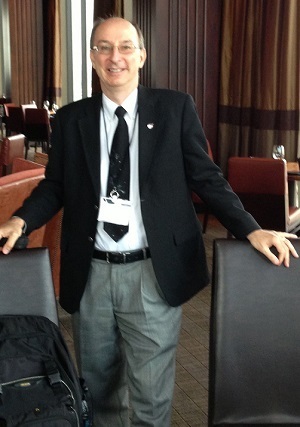
Sails can go to work for us here, and before we get to that level, we can chart a path of development with clear, practical uses that companies and governments can support. Yesterday I mentioned Les Johnson’s talk at Starship Congress in Dallas, in which he described ongoing sail efforts and noted that NASA’s Sunjammer sail was partly sponsored by the National Oceanic and Atmospheric Administration. Early warning for solar storms is a practical outcome and one space agencies should be able to use to gain funding. Meanwhile, we can watch private attempts like the Planetary Society’s Lightsail-1 and hope they can find their way to a launch manifest, which would continue to validate the model of commercial engagement.
Image: I knew I had at least one good shot of Les Johnson from the conference, but I couldn’t find it yesterday. A quick search of my iPhone pulled it out. The shot above was snapped at the Hilton Anatole’s top-floor restaurant the evening of the first day in Dallas.
One other kind of mission that Johnson mentioned, a sail rendezvous with a near-Earth asteroid, is certainly viable. There are various ways to operate around asteroids, but the sail offers you the option of visiting multiple objects, performing studies as needed and moving to the next target. Targeted missions by chemical or even ion rockets don’t have an open-ended target list, but the sail can rely on ever-present solar photons to keep it operational, giving us deeper insights into objects we have now begun to catalogue extensively for science and for planetary safety.
The Beam and the Near Miss
When it comes to putting a beam on a sailcraft to keep it operational even at distances greater than 5 AU — or to provide a huge velocity boost for closer-in missions between the Earth and Mars — we also need to be thinking about practicality. A Mars colony or an aggregation of asteroid miners in need of supplies could use the services of beamed sailships. Greg and Jim Benford have studied the effects of desorption of polymer layers on a sail, an effect caused by heating the sail with the beam that provides accelerations greater than those achieved by photons alone. Mars travel times of about a month can result from proper use of the beam.
We can imagine a network of sail-based supply ships as we spread out into the Solar System, an era in which we master solar sails and their beamed sailship counterparts while doing necessary work. Also intriguing at Starship Congress was another angle on the practicality of beaming, this one from Philip Lubin who, with co-researcher Gary Hughes, has been studying ways of dealing with asteroids on problematic trajectories. Lubin (UC-Santa Barbara) described what we might consider a directed energy orbital defense system using lasers fed by solar energy. It could be a major addition to our toolkit of asteroid deflection options.
Ironically enough, as Lubin told the crowd in Dallas, the white paper describing his DE-STAR system was released the day before the spectacular fireball over Chelyabinsk and the near-miss from asteroid 2012 DA14 reminded the world that asteroids can be dangerous. Lubin pointed out that 35,000 impacts from various objects have occurred in the last 4000 years, with about 100 tons of material entering the atmosphere on a typical day. Most of this is obviously not causing carnage, but we’re charting the orbits of large objects to make sure nothing threatens the planet with an extinction level event. We’d obviously like to get to where we could rule out Tunguska-class impacts as well, which are large enough to take out an entire city.
DE-STAR (Directed Energy Solar Targeting of Asteroids and exploRation) is a way to deal with such impactors. It would use a massive phased array of lasers to break up or evaporate the objects. The Santa Barbara team has calculated the requirements for a range of DE-STAR systems beginning with a desktop device and extending to 10-kilometer arrays and beyond. Their DE-STAR 2 is envisioned as a 100-meter system that could nudge asteroids or comets enough to avoid an impact.
But a 10-kilometer DE-STAR 4 could punch an asteroid with 1.4 megatons of energy per day, obliterating a 500-meter asteroid over the course of a year. Lubin described how space photovoltaics could be applied to create a beam of coherent focused light that would produce a spot size of about 30 meters at a distance of 1 astronomical unit. The beam would be applied to the asteroid when it was still distant, perhaps 1 AU out. And while totally evaporating an incoming object is feasible, it’s hardly necessary. The goal is simply to deflect it.

Image: UC-Santa Barbara physicist Philip Lubin. Credit: Paul Wellman/Santa Barbara Independent.
A phased array of lasers powered by the Sun scales up nicely in Lubin’s calculations from basic components that already exist to larger space-based installations with which we’ll have to develop expertise. Here again, though, there is a path of development and a clear rationale, planetary defense. And I’m sure you can see where I’m going with this: DE-STAR can produce the beam needed to drive a sailcraft to interstellar velocities. Lubin told the Dallas audience that a much larger DE-STAR 6 system could bring a 100 kilogram sailcraft up to 1200 kilometers per second over a range of 1 AU, while pushing it to 2 percent of the speed of light by the time it reached the edge of the Solar System.
Interestingly enough, there are a few SETI ramifications here as well. A DE-STAR 4 system is so powerful that when directed at another star it would be visible as the brightest star in the sky up to 1000 light years away. Those who think in terms of sending messages to extraterrestrial civilizations — and the subject of METI, always controversial, came up in Dallas, about which more later — could modulate a laser. Lubin’s is one way of creating the kind of interstellar beacon many of us think should not be built until we can reach a rational consensus about what the aims of such messages would be and what the possible risks of sending might involve.
The Triumph of the Small
I don’t want to close today without mentioning nanotechnology in sail terms, because as Eric Malroy made clear to the Starship Congress audience, mass is a critical concern as we move toward making larger sail structures. We want to push these things up to interstellar speeds, but the stronger the beam we put on the sail, the higher its temperature. So we’re looking for the right kind of materials to withstand the heat even while reaching incredibly low areal densities, at which point acceleration, in Malroy’s terms, ‘goes through the roof.’
A lot of work has already gone into sail materials, much of it by Geoffrey Landis (NASA GRC), who took Robert Forward’s aluminum sail structures and re-examined them. Niobium, beryllium and transparent films of dielectric (non-conducting) materials like silicon carbide, zirconia and diamond all fell under his attention as he searched for ways to bring sailships to higher accelerations while using smaller sails. Beryllium was an early front-runner but Landis went on to talk about sails made out of diamond-like carbon — a material much like diamond — that could be assembled in space with a plastic substrate. The beauty of this is that you can reach cruise velocity while still close to the laser source, thus using smaller sails and smaller lasers.
Malroy (NASA JSC) noted the possibility of using nanotechnology to print computing and sensor devices directly onto the sail, significantly reducing mass. The idea reminded me of Forward’s Starwisp, a microwave-driven sail that contained sensors at the various junctions of the spider web-like structure, so that instead of pulling a payload along behind, the sail and the payload were the same structure. Lenses and nano-transmitters could return imagery from distant solar systems using these techniques, and Malroy also described swarms of miniature beamed sails of the kind first described by Jordin Kare. In any event, he believes that by properly deploying nanotechnologies, we can reduce interstellar sail mass by 70 percent.
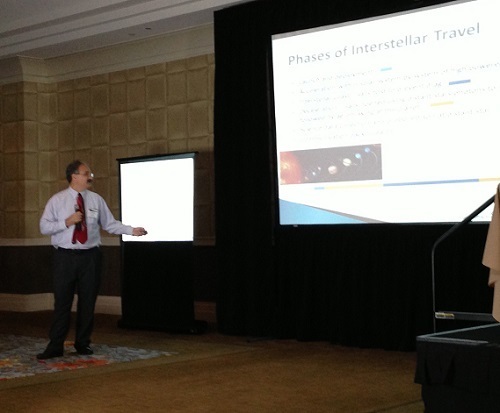
Image: Eric Malroy describing the uses of nanotechnology in beamed sailcraft.
If these concepts intrigue you, you can read more about Starwisp in Remembering Starwisp, though the archives contain a number of other Centauri Dreams posts that get into the concept. Jordin Kare’s ‘SailBeam’ micro-sails are described in Interstellar Propulsion Exotica. But we won’t get to the beamers needed to drive such spacecraft until we can show a sustainable path of development that begins with practical applications today. That’s why the idea of experimenting with phased arrays for asteroid mitigation appeals to me. It’s laboratory work we can perform now with implications that could take us out of the Solar System.
Tomorrow I’ll be looking at an intriguing concept for building an interstellar infrastructure that was presented at Starship Congress. For now, though, let me mention that the paper on sail desorption mentioned above is Gregory Benford and James Benford, “Power-Beaming Concepts for Future Deep Space Exploration,” in the Journal of the British Interplanetary Society Vol. 59 No. 3/4 (March/April 2006), pp. 104-107. Jim Benford didn’t get into the desorption issue in his Dallas talk, but it’s provocative and gives sails an added kick.
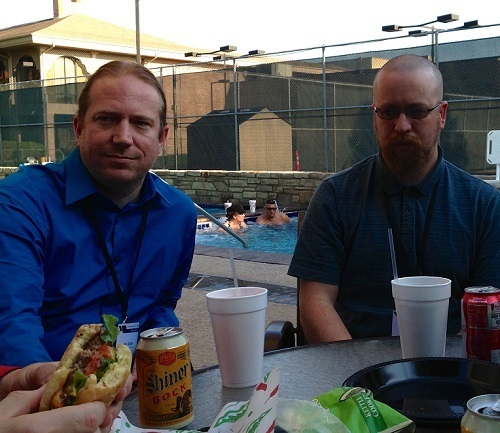
And to close, this final photo, showing my son Miles and science fiction writer Oz Monroe, who flew in from the West Coast for Starship Congress. We had a great dinner sitting around the Hilton Anatole’s pool with Sonny White along with Rob Adams (NASA MSFC) and his wife Tia. The cheeseburger you see here is Sonny’s.






August 21, 2013
The Path to Beamed Sails
Several years ago in Italy Les Johnson told me that he had once had the coolest job description in NASA. And I remember those days in the early 2000s when I was just beginning to investigate interstellar issues, and Les, working at Marshall Space Flight Center in Huntsville, carried a NASA business card describing him as ‘Manager of Interstellar Propulsion Technology Research.’ These days Les’ title is not quite as exotic but he’s involved as ever with solar sails.
Les is also an author, and among his many books is one I recommend to anyone trying to learn more about solar sails. Written with Gregory Matloff and Giovanni Vulpetti, Solar Sails: A Novel Approach to Interplanetary Travel (Copernicus, 2008) reviews the history of the concept going back to James Clerk Maxwell, who pointed out in his monumental work on electric and magnetic fields that photons can impart force to an object they encounter. Konstantin Tsiolkovsky and the Latvian scientist Friderikh Arturovich Tsander went on in the early 20th Century to describe huge mirrors made of thin materials that used photons for propulsion.
Johnson pointed out to the audience at Starship Congress in Dallas that the effect of photons on spacecraft was readily apparent as early as 1960, when NASA launched ECHO 1, a communications satellite that was essentially a giant metal balloon off which signals could be bounced. A large reflective object like this responds to the momentum being exerted upon it by photons, an effect that could now be observed in space. But a lot of people aren’t aware of what Les went on to describe, the use of photon-imparted momentum to save Mariner 10.
Launched in 1973, the craft used a gravity assist around Venus to put it on a trajectory to study Mercury, entering a solar orbit that would allow several close passes by the planet. Flaking paint from Mariner 10’s high-gain antenna confused its navigation sensors, ultimately causing the spacecraft to roll, activating its gyroscopes and venting critical attitude control gas into space. The guidance and control team at JPL was able to solve the problem by tilting Mariner’s solar panels, allowing photon pressure to create enough torque to counter the aberrant motion.

Image: Les Johnson in a NASA photo. My inexpert camera work didn’t produce a good image during Les’ talk in Dallas, so I rely on Google’s image database.
Sunjammer and Its Contemporaries
The point could not be clearer: We know a lot about the physics here, and with solar sails, even though we have only two thus far successfully launched, we’re dealing with principles that have been understood for a long time. There was serious talk about a solar sail mission to Halley’s Comet in the 1980s, with a team at JPL developing several sail designs, among them a heliogyro with multiple blades and a sail that reached 640,000 square meters, a half mile to the side. The comet mission would have jump-started the sail business but NASA rejected the proposal as too risky. Lou Friedman, former director of the Planetary Society, has written about all this in another book you’ll want on your shelf. It’s Starsailing: Solar Sails and Interstellar Travel (John Wiley & Sons, 1988), a bit hard to find these days but well worth the effort.
I had heard about the Japanese IKAROS sail before it launched in 2010 but the reality of it didn’t really sink in until I watched the actual launch. I had a window up on my computer when my wife walked by and asked what I was looking at. “The Japanese are launching a solar sail,” I said, preoccupied as the countdown continued. She walked on out of the room and then came right back. “They’re launching what?!” She knew all about solar sails (the consequence of living with me), but she was startled that after all the NASA work, along with serious studies by DLR in Germany and the Russian Progress mirrors, it was Japan that actually took a sail into space.
Johnson told me after his talk that IKAROS had truly galvanized the sail community. NanoSail-D, launched late in 2010, came next, a three-unit CubeSat that had been built as a spare for an original sail that was lost in a 2008 launch attempt. I still remember Greg Matloff calling me up after the first launch failure to tell me there was a second NanoSail, and I told him he reminded me of S. R. Hadden, the billionaire in the film Contact who tells Ellie Arroway that there is a second stargate machine after the first one is destroyed. “Why build one when you can build two for twice the price?” says Hadden, memorably played by John Hurt.
The second NanoSail-D did the trick, deploying a 10 square meter sail after a rather dramatic delay. The sail spent 240 days in orbit before re-entering the atmosphere. Now, of course, we have Sunjammer to look forward to, a major step up from NanoSail-D. NASA is saying that Sunjammer will produce a maximum thrust of approximately 0.01 newton, the rough equivalent of the weight of one of those packets of artificial sweetener you see on cafe tables. That level of thrust makes the point that sails operate slowly but surely, with a constant acceleration that, over time, achieves velocities fully compatible with exploring the inner Solar System.
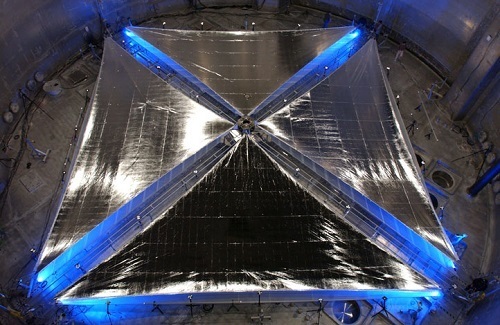
Image: NASA engineers look at a 20-meter solar sail and boom system, developed by L’Garde Inc. of Tustin, Calif., after it is fully deployed during testing at NASA Glenn Research Center’s Plum Brook facility in Sandusky, Ohio. Red and blue lights help illuminate the four triangular sail quadrants as they lie outstretched in Plum Brook’s Space Power Facility — the world’s largest space environment simulation chamber. The sail material is supported by a series of inflatable booms that become rigid in the space environment. Credit: NASA/MSFC.
A Clear Roadmap for Sails
For interstellar purposes, of course, we want to do more than move supplies around the Solar System, and that is why Robert Forward started thinking in the early 1960s about pushing a huge solar sail with lasers. We might call this a ‘beamed sail’ or perhaps a ‘lightsail,’ though I like ‘beamed sail’ better because microwaves may be an even better way to push a sail and ‘lightsail’ implies lasers. In any case, the beaming idea is what counts, and Forward was soon joined by George Marx in exploring the idea. Marx wrote up a laser-driven sail concept in Nature in 1966, and we’ve been taking it apart and putting it back together ever since.
The path of sail development, though, is clear, as Johnson explained to the Starship Congress audience. You get to beamed sailcraft by first developing expertise with conventional solar sails. When the Planetary Society was attempting to launch its Cosmos sail in 2005, the plan had been to deploy and test the first operational sail, and as a part of that process a beamed microwave experiment was planned using the Deep Space Network’s Goldstone facilities. We would have learned much about the forces on the sail and how to maneuver it using both solar photons and microwaves if the craft had not been destroyed in a failed launch attempt.
We must hope Sunjammer has a better fate in its 2014 launch. Johnson said the design uses inflatable booms that are malleable and thus deployable, after which they become rigidized by the cold. The plan is to demonstrate attitude control and test the stability of the craft while performing maneuvers and moving close to the L1 Lagrange point to make scientific observations for NOAA (National Oceanic and Atmospheric Administration), which is one of the sponsors of the flight. There’s already a NOAA satellite at L1 that allows a ten to fifteen minute warning of solar storms. The beautiful thing about a sail is that it can move closer to the Sun than L1 and essentially ‘hover’ there, doubling the warning time for potential flare-induced power outages.
Of course, there are many things you can do with a solar sail, and Johnson’s comments ran the gamut. A geosynchronous satellite circling the Earth above the equator is able to stay over the same location on Earth, but you can’t accomplish that trick if you want to hover over the poles for scientific studies. Not unless you use a sail in a ‘polesitter’ orbit that relies on photon pressure to maintain its position. Robert Forward took out a patent on this concept, which he called a ‘statite,’ meaning a spacecraft that, although not orbiting, essentially hovers in place.
Forward wrote the concept up in a 1990 article for Analog and later in a story he called “Race to the Pole.” He describes how the sail would be positioned over the polar regions:
“.. . with the sail tilted so the light pressure from the sunlight reflecting off the lightsail is exactly equal and opposite to the gravity pull of the Earth. With the gravity pull nullified, the spacecraft will just hover over the polar region, while the Earth spins around underneath it.”
You can see what’s happening here: You’re balancing the Earth’s gravity and that of the Sun along with the centrifugal force of the Earth’s orbit around the Sun. A polesitter like this would be stable at about 250 Earth radii, a lot farther out than most communications satellites (about 6 Earth radii), but while this would be problematic for voice communications, it would be no problem for broadcasts into polar regions, and would allow useful meteorological studies.

Image: Dallas as viewed from my hotel room after the first day of Starship Congress.
I’ve hardly exhausted the sail mission concepts that have been studied, so we’ll continue in the same vein tomorrow. From a longer-term perspective, though, I want to emphasize that sails are a technology that can pay off at every level of development. As we look at practical uses for these craft in the near future, we can also contemplate developing them as interplanetary vehicles, perhaps as carriers of supplies to bases on Mars or the asteroids. And we can begin testing how sails behave under beamed power, knowing that building this expertise may one day lead us to space-based beamers that can drive a sailcraft out of our Solar System on an interstellar trajectory.






August 20, 2013
Key Issues for Interstellar Sails
The evening after Jim Benford’s Starship Congress talk on his solar sail lab work at the Jet Propulsion Laboratory, a small group of sail advocates joined him in the Hilton Anatole’s top floor restaurant to talk over the issues. Benford is organizing Project Forward, named after the legendary Robert Forward, as an Icarus Interstellar effort to further refine the interstellar beamed sail concept. Asked to name the biggest problem areas for sails, the group came up with several, but at the top of the list was deceleration. How do you slow a beamed sail down when it arrives at its target?
A number of possibilities suggest themselves and at this point all of them are completely theoretical. Forward himself wrote up a ‘staged sail’ concept, in which the outer ring of the sail detaches as the star is approached, moving ahead of the inner ring and attached payload. The Earth-based beamer bounces the laser off the larger sail ring, which reflects it back to the smaller sail and slows it for orbital insertion. The maneuver is described in Forward’s 1984 novel Rocheworld, where a three-part sail is used to allow for crew return.
Here’s Forward’s description of a mission to Barnard’s Star on the sailship Prometheus as the sail staging has begun. The inner sail (and payload module) is being turned around so as to receive laser light from the outer ring segment, called the ring-sail:
As the central sail was almost halfway around, the ring-sail readjusted again and started to bring the rotation of the central sail and Prometheus to a halt. The teamwork of the four computers was perfect. The rotation stopped at the same instant the central sail was exactly one hundred and eighty degrees around. The central sail now had its back to the light coming from the solar system while it faced the focused energy coming from the ring-sail. Since the ring-sail had ten tines the surface area of the central sail, there was ten times as much light pressure coming from the ring-sail than from the solar system. The acceleration on the humans built up again, stronger than before, but now it was a deceleration that would ultimately bring them to a stop at Barnard.
Have a look at the diagram below to see the basic method. If the image looks familiar, it’s because this is one of the few I’ve found illustrating Forward’s idea, taken from his original paper on a mission to Epsilon Eridani. Remember that Forward was assuming a huge lens in the outer Solar System which would be used to keep the beam tightly collimated. You can see how complicated this is, and why a magsail also suggests itself as a somewhat more direct option, though braking against a star’s stellar wind brings up numerous problems of its own.

Image: Forward’s separable sail concept used for deceleration, from his paper “Roundtrip Interstellar Travel Using Laser-Pushed Lightsails,” Journal of Spacecraft and Rockets 21 (1984), pp. 187-195. The ‘paralens’ in the image is a huge Fresnel lens made of concentric rings of lightweight, transparent material, with free space between the rings and spars to hold the vast structure together, all of this located between the orbits of Saturn and Uranus.
If you look at the Forward scheme, though, you can see why the second big problem for beamed sails is jitter. No matter how accurate your beamer, you’ve got huge issues trying to deliver a laser beam to a sail ten light years away, a kind of accuracy that’s just as breathtaking as the power requirements for driving the sail in the first place — Forward’s Epsilon Eridani mission calculation cited a power requirement of 7.2 terawatts. In fact, in a 2003 paper, Travis Taylor and Gregory Matloff took note of the jitter issue and how far we are away from solving it:
The analysis given here, which did not take into account pointing jitter, suggests a minimum of about 15 km in radius for the collector. If pointing error is considered, it appears that the current state-of-the-art of jitter control is many orders of magnitude from enabling a laser sailing mission. Beam control is the largest obstacle for laser sailing.
Building Large Structures in Space
But it’s interesting to see that useful work is being done on the matter of building and deploying large structures in space. Forward’s company Tethers Unlimited, which he founded in 1994 in partnership with Robert Hoyt, has just been awarded a $100,000 grant to develop its SpiderFab project, which will use 3D printing methods in orbit to create the kind of structures we need. You can see how critical this is: Right now a major part of the cost of engineering and launching space systems revolves around the demands of surviving the launch phase, not to mention the cost of the launch itself. Tethers Unlimited plans to find ways around the problem, as described in a report Hoyt wrote for NASA:
We propose to develop a process for automated on-orbit construction of very large structures and multifunctional components. The foundation of this process is a novel additive manufacturing technique called ‘SpiderFab’, which combines the techniques of fused deposition modeling (FDM) with methods derived from automated composite layup to enable rapid construction of very large, very high-strength-per-mass, lattice-like structures combining both compressive and tensile elements. This technique can integrate both high-strength structural materials and conducting materials to enable construction of multifunctional space system components such as antennas.
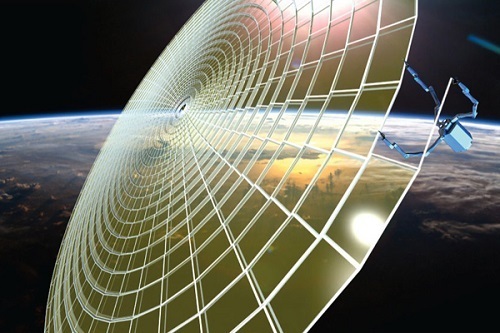
Image: SpiderFab combines techniques evolved from terrestrial additive manufacturing and composite layup with robotic assembly to enable on-orbit construction of large spacecraft components optimized for the zero-g environment. Credit: Tethers Unlimited/NASA.
Rob Adams (NASA MSFC) described current work on 3D printing in his session at Starship Congress, a technique that would make it possible to create parts on the fly, and one that could even be used for printing out various kinds of foods — NASA has been looking at 3D treatments of pizza (I kid you not) as an experiment in lowering food waste and varying what astronauts eat to go beyond the typical pre-packaged fare. SpiderFab is a step further, the kind of robotic technique that could one day be used not only to build kilometer-scale sails but also key parts of the beamer.
We’re in the early days of sail design but we’re making progress, both in the lab and in space through missions like IKAROS and NanoSail-D. I think too about the two sails that NASA deployed at its Plum Brook facility in Sandusky, Ohio in 2005. These were demonstrators built within a vacuum chamber that have paved the way for Sunjammer, a mission Les Johnson described to the Starship Congress audience. Sunjammer folds up into something the size of a dishwasher, but when deployed in space it will have spread to 1200 square meters, seven times the area of the IKAROS sail, while weighing a scant 32 kilograms (ten times less than IKAROS).
Launch of Sunjammer is currently planned for next year. The mission stirs fond memories of Arthur C. Clarke, whose story “Sunjammer” inspired its name. We should also acknowledge Poul Anderson, who confusingly enough published a story of the same name in Analog a month after Clarke’s story appeared in a 1964 issue of Boy’s Life. You’ll find the Clarke story retitled “The Wind from the Sun” in many anthologies, but whatever its name, the story of a solar sail race to the Moon firmly established the sail concept as a player in the minds of science fiction readers and helped its acceptance by the public.
Johnson, whose recent book Going Interstellar (co-edited with Jack McDevitt) should be on the shelf of any interstellar advocate, went on to describe the Sunjammer mission and a number of other sail concepts currently under development. I had intended to get to all of these today but in my enthusiasm I’ve run out of time, so we’ll continue with more of Les Johnson and talk of where sails are going tomorrow. I was glad to see that Starship Congress was heavy on sail technologies, including the uses of nanotechnology and an interesting idea for a beamed laser infrastructure that we’ll be examining as I continue sorting out my notes.
The Taylor and Matloff paper referred to above is “Space Based Energy Beaming Requirements for Interstellar Laser Sailing,” CP664, Beamed Energy Propulsion: First International Symposium on Beamed Energy Propulsion, ed. By A.V. Pakhomov (2003), American Institute of Physics 0-7354-0126-8.






August 19, 2013
The Sail Comes to Texas
Low clouds had descended upon Dallas when I landed at Love Field, and by the time I got to the Hilton Anatole for the Starship Congress being hosted by Icarus Interstellar, the city outside was swathed in mist. This was last Wednesday evening, and it was late enough by the time I had dinner that a quick stroll through the cavernous facility was about all I wanted to do before getting some sleep. The Anatole, though, was gorgeous, filled with paintings and sculpture, some of which (two statues of elephants) became helpful landmarks as I learned to navigate the place.

Image: An atrium at the Hotel Anatole at night, one of two, connected so that inveterate walkers like myself could make figure-eight circuits by following the room corridors on any floor.
Starship Congress was a roaring success, the kind of thing that happens when you put people with passionate interests in the same place who usually know each other only through email or by reputation. Saving the day for me on day one was my friend Pat Galea, an Icarus Interstellar fixture, who had brought one of those little MiFi ‘hotspots’ with him. For we learned that the hotel wireless didn’t extend into the meeting room, but Pat, who is to computer issues what Itzhak Perlman is to violins, soon had four of us up and running with a slow but adequate connection. That allowed me to send out the occasional tweet and check various things on Google.
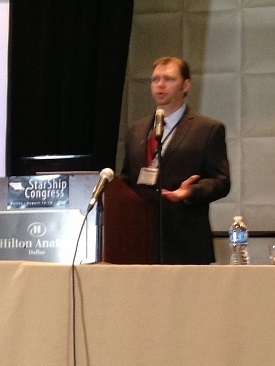
I was glad that the Icarus Interstellar Kickstarter campaign had gone as well as it had, raising a good deal more than the initial goal, and thus funding the travel costs of a number of speakers. We’re all learning our way with crowdsourcing tools like Kickstarter, but they offer a level of public engagement that Richard Obousy, Icarus Interstellar’s president, acknowledged in his opening remarks. In the post-Apollo era, everyone is aware of the need to find ways to engage the public in the great issues of space exploration, and having a stake in an interstellar conference, even if the contributor can’t make the trip, is one way to get this done.
Riding the Sail
My conviction is that the first serious mission targeting another star will use sail technologies in one form or another. The first conference session was devoted to sails, leading off with Jim Benford’s keynote, followed by Les Johnson, who described current and near-term work. Right now the only propulsion method that will get us to interstellar velocities is the sail, and even then we’re talking no more than a couple of hundred kilometers per second, so it’s still a long trip. The Alpha Centauri crossing at 300 kilometers per second (perhaps realizable through a close pass by the Sun with deployment of the sail at perihelion) would still take 4300 years.
This is always a bit of a mind-bender because Voyager 1, the fastest probe we have leaving the system right now, moves at a ‘mere’ 17 kilometers per second, and while New Horizons topped that briefly in the early part of its journey, it will ultimately pass Pluto/Charon at about 13.9 kilometers per second. We need to find ways to ramp these numbers up, and that search begins in the lab. What Benford described in the opening session was a series of experiments he and his brother Greg made on beamed propulsion back in the year 2000. The researchers were working with a carbon fiber mat shaped into a small sail with a thickness of less than 1 millimeter.
Carbon fiber is ideal for sail work because when you put a microwave beam on the sail the material absorbs energy and begins to heat. A sail made of aluminum would begin to melt as you reach about 900 K, limiting possible accelerations, but carbon fiber has a low areal density (about 8 grams per square meter in the material the Benfords used) and a microwave reflectivity approaching 90 percent. The material is actually a carbon-carbon microtruss, meaning a core of carbon fibers is fused to a textured outer surface. With carbon nanotubes woven into the material, this microtruss is capable of temperatures up to 3000 K, at which point it doesn’t melt but sublimes, going from solid to gas with no intervening liquid state.
Working with a sail in an Earth-bound laboratory means you have to achieve an acceleration of one g just to lift off, but the Benfords were able to get up to 10 gs in these experiments, using a wavelength of about 3 centimeters and a pulse duration of 0.2 seconds. Although the tiny experimental sails began to heat up at higher beam powers and bounced off the ceiling of the lab, they survived and remained undamaged after the flight.
All this is provocative because a normal solar sail — think Japan’s IKAROS, for example — is pushed solely by sunlight, the fact being that while photons have no mass they do impart momentum. That’s fine when working in the inner Solar System but the effect of sunlight drops drastically as you move outward, dropping off by the inverse square of the sail’s distance from the Sun. In other words, a sail at Jupiter’s 5 AU from the Sun receives only 4 percent of the sunlight it would in Earth orbit, so an outbound sail is going to need a microwave or laser push if we want to keep it under acceleration all the way to system’s edge and beyond.
Enter the Beam Riders
The laboratory work that has been done thus far is highly encouraging. Having learned that a sail can indeed be pushed to high accelerations by using a microwave beam, the Benfords were also able to show that a sail of the right shape — concave and something like a parachute — will be stable and stay centered in the beam. In fact, the beam induces a sideways restoring force so that even assuming a certain amount of ‘jitter’ in the beam itself, the sail is capable of riding the beam. We’re a long way from the laboratory to the gigantic sails envisioned by Robert Forward, but we’re getting good indications that once we have the expertise to build the right kind of ‘beamer’ in space, the physics will allow sail missions that can reach interstellar velocities.
Transmitting angular momentum to a sail through a beam of photons has also been demonstrated and is, in Benford’s words, ‘a trivial process,’ so that sail deployment might become a matter of putting a large sail into space and inducing a spin to unfold it. Whatever deployment method might be used, the fact that a beam can carry angular momentum means that controllers can stabilize the sail against yaw and drift once deployed. Keep in mind, too, that a number of sail mission concepts actually call for lower power densities than the Benfords needed in the lab — remember, they were pushing the sail from deep within a gravity well. So the experimental case for beamed sails is solid and we can look forward to space-based testing.
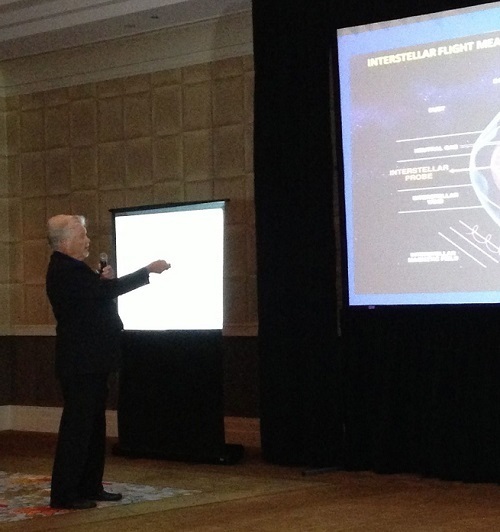
Image: Jim Benford discusses the experiments he and his brother performed on sail beaming at the Jet Propulsion Laboratory.
Half a million dollars produced the results Benford described, making the point that while we do have these initial results, we lack a large body of data to draw from not just with sails but most other interstellar propulsion proposals as well. “We have far too many concepts and far too little data,” Benford reminded the audience, adding that “Nature will produce the answers if we ask the correct questions.” Indeed. And these experiments tell us that useful work this early in the interstellar process can grow out of laboratory studies that aren’t hugely expensive. The interstellar community should be thinking about how it can support such ground-breaking work not only on sails but other proposed solutions to the interstellar propulsion conundrum.
One of the exciting thing about interstellar studies is the sheer number of questions it raises. With sails we are dealing with a subject that has moved out of the conceptual phase. We know the physics and are beginning to demonstrate sail methods here on Earth. We can now move in two directions, the first being to work on new materials that will be lighter and more responsive to the beam on the sail. The second step, an obvious one, is to continue with actual space deployments of sails and begin to do beaming experiments on them. More tomorrow as I look at other sail presentations from Starship Congress, beginning with Les Johnson’s overview on what we’ve accomplished so far in space and what we can expect in the next few years.






Paul Gilster's Blog
- Paul Gilster's profile
- 7 followers



